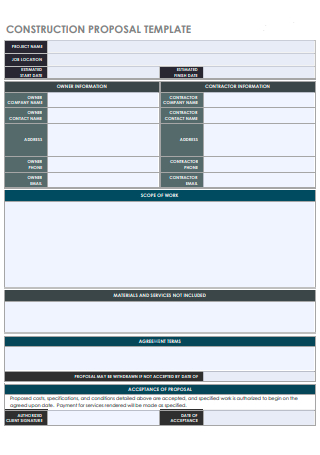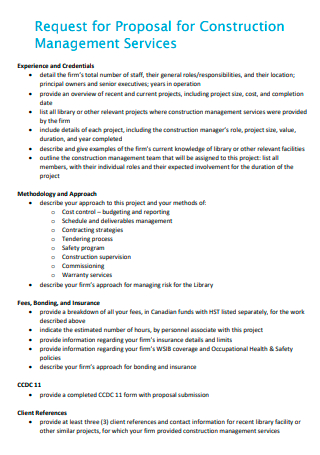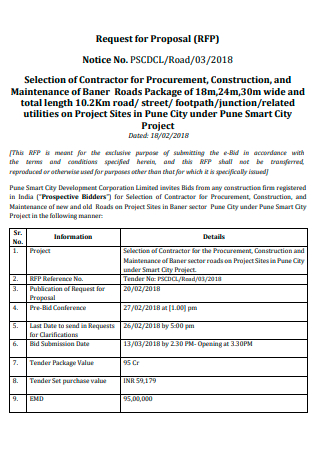3+ Sample Construction Client Proposal
FREE Construction Client Proposal s to Download
What Is a Construction Client Proposal?
A construction client proposal is a formal offer from a bidder to the owner, preferably on a pre-determined proposal form, to complete the job and provide all labor, materials, equipment, and any services for the bidder’s quoted prices and terms. Building, producing, and designing are all aspects of construction. However, before you can move on to serious matters, you must first draft a proposal for a construction project. Your proposal must be excellent if you want to impress potential investors and get their approval for your project. Check out the sample proposal available and also stop by and view the proposal templates.
Duties of Clients
As the client, there are responsibilities you will have to handle. One in which particularly you must ensure that construction activity is appropriately planned, resourced, and managed to protect the health, safety, and welfare of everyone working on or affected by your project. Go over the contents of this article where we have curated a list for you of what you will need to keep in mind as a client working with a construction company on a particular project of yours.
Management Arrangements: Since the project is initiated by the client, the customer frequently defines the overall program, and the client pays for the work to be completed, the client has a significant impact on the project’s conclusion. Even though the amount of their involvement in the project will not be dependent on their knowledge and experience of construction processes, clients should set the ground rules for health and safety. Large clients may have their in-house design team as well as their direct labor contracting staff. Smaller clients may need to invest in the skills they want and may require professional assistance.Time and Resources: The customer must also offer enough time and other resources for all parties engaged to meet their health and safety responsibilities, according to the requirements. The lead designer’s input will be vital in determining timeframes for notifiable projects. On non-notifiable projects, the client must nevertheless seek guidance on the planned allocation of time and resources to the various phases of the project. The customer must budget enough time for design, design reviews, planning, hazard identification, risk assessment, risk control measure specification, contractor selection, mobilization, sequencing, and scheduling of work, and construction.Pre-Construction Information: On all projects, the client must supply information to the designers and contractors about the project, the site, and other pertinent issues. This information will be useful to designers in their efforts to eliminate or reduce risks caused by their design decisions, to tendering contractors in properly evaluating the work and its associated risks, and to contractors performing the work in their health and safety management on the job site. The client must provide this information early enough for the designers to examine it to eliminate or reduce risk through design. The pre-construction information could be in the form of drawings, reports, surveys, and other documents.Designate the Principal Designer and the Principal Contractor: On notifiable projects, the client’s involvement includes appointing a qualified principal designer and competent main contractor. The project’s design and planning will be overseen by the primary designer, who will also support the client in carrying out their responsibilities. The health and safety components of the construction are managed by the prime contractor. The lead designer should be appointed as soon as feasible once the initial design process begins. The client may have formal agreements in place with the primary designer and principal contractor, stating how the project will be managed and subsequent responsibilities will be fulfilled.Ensure Co-Operation and Co-Ordination: The customer must take measures to ensure that all members of the project team are cooperating and coordinating well. The Principal Designer and the Principal Contractor do an excellent job of this, and the client only needs to keep track of their progress. On all projects, the client will need to be heavily involved in the project design and construction processes to ensure that all parties are cooperating and coordinating their designs and construction activities to comply with the law and produce a cost-effective and efficient project. Each party is responsible for informing its employees about the criteria for coordination and the measures that must be taken.Prepare the Construction Phase Plan: Before enabling construction to begin on any project, the customer must check that the construction phase plan has been appropriately created by the principal contractor. The health and safety management systems and arrangements for the specific project and locations, as well as risk assessments and method statements for the beginning work activities, must be included in the construction phase plan for it to be regarded properly developed. It is advised that a documented plan, roughly resembling the construction phase plan, be created and reviewed for any projects involving demolition or places or activities having high levels of risk.
Construction Business Growth Strategies
It takes a lot of effort to grow your construction company from small to sustaining to towering success. When it comes to expanding your business, there are several variables to consider. From expanding your network to establishing an online presence to utilizing the appropriate technologies, each step is critical to your success. This post has compiled a list of the best construction business growth tips.
Make Customer Service a Top Priority: It’s evident that determining whether or not an employee has the requisite contracting skills is critical when hiring. Almost as important, however, is ensuring that they can give excellent customer service. Your clients will remember the work you did for them, as well as how you handled them along the process. Putting together a team of employees who will treat your clients with respect, patience, and understanding will go a long way toward ensuring that your company receives repeat business and valuable referrals.Maintain Your Involvement: There are two elements of this phase that dictate that you must always be accessible to your customers. For those unfamiliar with construction, it can be a perplexing process, so your clients may have questions or simply want to know how things are progressing. The more time you give them to express themselves and address their problems, the more likely they are to hire you again or refer you to a friend. Second, keeping involved entails showing up on the job site to monitor. You can’t be everywhere at once, but your clients and employees must be aware that you will be dropping by regularly.Find Your Area of Expertise: There are so many various types of contracting; if you have a specialty, let people know about it. Promoting your company as a leader in a specific area, such as window installation or roof repair, is a wonderful method to ensure that you are the first call a client makes when a window cracks or the roof begins to leak. Even if you are a general contractor, you can market your company as the greatest in various niches by offering a wider range of services. You can start with one particular niche and then slowly expand that to cover multiple services.Provide Proof: You can flaunt your business at networking events and list all of the services you offer on your website, but if you lack social proof of client satisfaction, it may be tough to acquire potential consumers’ trust. Online reviews, testimonials, project galleries, and case studies can all help to build confidence. Make sure to get feedback from customers and refer them to popular review sites. If clients are hesitant to leave an online review, you might request a testimonial that you can display on your website instead. A project gallery on a construction company’s website is beneficial.Be Well-Organized: Finally, maintaining order is critical to running a successful organization. You will want to keep meticulous records to ensure that you are staying on track with your budget and, of course, being paid for your labor. This also entails keeping track of how much time and energy you will need to devote to each type of service you provide. This can help you avoid spreading yourself too thin by taking on too many clients or responsibilities at once. It may appear that having more customers is always better, but this is only true if you don’t have to sacrifice the attention you can give to each one.Cover Your Bases: A business needs insurance, especially if the heavy gear and electric instruments are used regularly. Make sure you and your company are protected against any injuries, property damage, and litigation. Finding the correct insurance coverage for you is simple these days, especially when you can discover affordable, specialized insurance products tailored to your industry. You have to keep in mind that the safety and protection of your employees will effectively be seen by the client and positively reinforce your reputation.Launch an Official Website: It’s one thing to have a well-run business that produces excellent jobs; yet, if you don’t have a website, your target audience will have a tough time finding you. Whether you have a current website that needs to be updated or you don’t have one at all, we advocate making this a top priority. Your website should provide useful information about your organization and services, as well as answers to frequently asked inquiries from clients. It should show how your services help them address their difficulties. When developing or redesigning your website, work with a web developer and a search engine optimization (SEO) company.
How to Write a Construction Client Proposal
The format of a construction proposal varies depending on whether it is a marketing or a bid proposal. The former promotes your services, while the latter secures your employment. If you have a sales team made up of marketers, business developers, and estimators, it’s a good idea to create a construction client proposal to help with the discussed details be put in an organized manner. It will aid in the bidding procedure for construction company developers and estimators. For additional assistance, you can look into the available sample construction client proposal letter as well as the construction proposal example.
Step 1: Cover Letter
A cover letter is a good place to start when writing a proposal. Information such as the addressee and you, the one responsible for who wrote it. This is where you can state the problem and describe how you plan to fix it. You can also include deliverables, which are the benefits of your proposal and what type of good changes your project will bring to the area and the people that reside there. It should, in general, sell your project.
Step 2: Company Profile and Contact Information
You will provide specifics about your company in this area. Extend the purpose and vision statements of your company. However, keep it quick and hit the highlights, and don’t undersell yourself. If you’ve worked on any other important projects, be sure to include them. After that, include a section with your company’s name, address, website address, email, phone number, and other essential information in the contact information section. You can also provide your contact details.
Step 3: Team References
In this section, your client may be curious about who will be working on the construction project. This is where you will list out the names of the professionals in charge of handling the project. Labeling them on their specific tasks and expertise will help notify the client of what their role is. You can also include a photo to make it easier for the client to track who is who.
Step 4: Cost
You will want to go over your construction budget in great detail in this part. People want to know how much something will cost them and exactly what their money will buy. Include materials, equipment leases, labor costs, subcontracting prices, and zoning fees in your budget. Add a success criteria section after the costs that discusses your project’s goals and how the spending fits into those goals. This demonstrates to consumers that their money will be spent on items they can envision.
Step 5: Agreement Terms
The part of the proposal where you will elaborate more on the terms involved for the entire duration of the project. Specify how the payment terms will be arranged, whether or not the transaction will be done through bank installment or on monthly bases should be decided upon. Mention the construction bond and permits, as well as the construction materials necessary for the project, the team’s work schedule, compliance, and lastly the warranties.
Step 6: Secure Signatures
Your agreement statement should be the last portion of the proposal section, but it’s placed under this topic because the agreement statement should always end with a signature page. Finally, there should be a signing page with space for the signatures of both the contractor or construction owner and the client or consumer. It should also be signed in front of a witness and notarized.
FAQs
What is the distinction between a contract and a proposal?
A contract must have four parts to be legally binding: an offer, incentive, agreement between two parties, and collective agreement. Simply put, a proposal is an offer made by one party to another to provide a solution, service, or sell something. A proposal isn’t a legally binding contract; rather, it’s a sketch of how you might collaborate with someone.
How do you write a proposal for a bid?
Construction bids and how to win work in construction rely heavily on bid proposals. A construction bid proposal must be accurate, timely, and unambiguous. It must build the necessary trust for your client to award you the assignment. Of course, what you provide in your bid proposal is crucial, but so is the design and structure that convey this information. Keep those in mind when you write out the construction bid proposal.
How long does a construction project last?
This project usually takes 3-4 months to complete. But keep in mind that this is merely a three-month project and other projects may even last longer. Even if the construction just takes a few months including the development of the construction client proposal, the planning, design, and permitting stages can make this project take twice as long.
A strong construction proposal provides all of the information necessary for the prospect to make an informed decision. Construction proposals are critical to your success in the construction industry, whether you’re trying to get your company on a potential client’s bid list or competing for a job. It goes without saying that both marketing and bid proposals must be clear, simple, and precise. To cement the deal and acquire a building contract, use the easy construction proposal template supplied.




